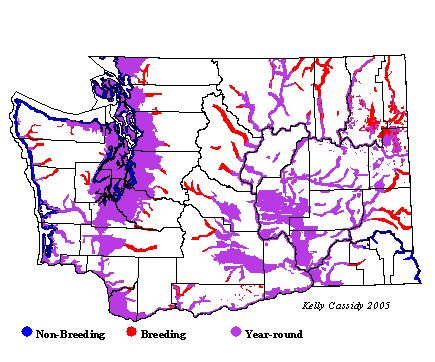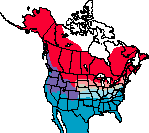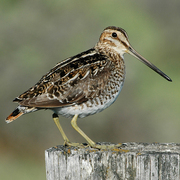Wilson's Snipe
General Description
Wilson's Snipe is a rather chunky shorebird, with a short neck and short legs. Its straight bill is very long. It is colored cryptically in mottled brown and black, with prominent light buffy longitudinal stripes on both its head and back. Its flanks are heavily barred, and its tail, barely visible when the bird is on the ground, is a rusty orange. Males, females, and juveniles have virtually the same appearance, and there is no seasonal variation in plumage.
Habitat
Wilson's Snipe breeds in lowland, freshwater marshes and wet meadows with emergent vegetation, especially sedge meadows. During migration and winter, snipes can also be found in salt marshes, estuaries, and other mucky areas.
Behavior
Wilson's Snipes are relatively solitary, but may form flocks. They move slowly through vegetation, probing deep in the mud with a repetitive up-and-down 'sewing-machine' motion. They are best seen during the breeding season when males sing from the top of perches such as fenceposts. When snipes are approached, they often burst away in a zigzag escape flight. One of the most distinctive sounds of Wilson's Snipe is a winnowing sound made by air rushing through its stiff outer tail feathers as it dives from high in its display flight.
Diet
Wilson's Snipes eat insects, earthworms, and other creatures that burrow in wet soil. They also eat leaves and seeds.
Nesting
Males arrive on the breeding grounds 10 to 14 days before females. They establish territories and, once they arrive, attract females with their dramatic flight displays. Females build their nests on grass or sedge hummocks. The nest is a shallow depression lined with moss, leaves, and grass, sometimes with plants from above woven in a canopy. The female lays 4 eggs and incubates them by herself for 18 to 20 days. The young leave the nest shortly after hatching, and both parents tend the brood, often splitting the group and each taking one or two young. The parents feed the young at first, although the young start to probe for their own food at about six days. By ten days of age, they find most of their own food. The parents continue to supplement their diet until they become independent (18 to 20 days).
Migration Status
Wilson's Snipes are found throughout the US and are partially migratory. Some move north into Canada, Alaska, and the northern US tier and some winter in the central and southern US, Mexico, and Central America. (But see "When and Where To Find in Washington" below.)
Conservation Status
Both the Christmas Bird Count and the Breeding Bird Survey in Washington have indicated that Washington's Wilson's Snipe population is in decline. This species is difficult to survey, however, and these numbers may not reflect the actual population. The Canadian Wildlife Service estimates the current population at 26,750,000 worldwide and 2,000,000 in North America, although the North American form is often considered to be a separate species. The destruction of wetlands continues to reduce available habitat. Wilson's Snipe is a game bird in Washington. Annual harvest rates vary considerably throughout the state and have ranged from 879 to 164,595 birds taken statewide within the past ten years.
When and Where to Find in Washington
In western Washington, Wilson's Snipes are uncommon and local and, though most are resident birds, breeding records are rare. In eastern Washington, Wilson's Snipe is a common breeding bird and may be found at all elevations where there is appropriate wetland habitat. Most eastern Washington snipes are short distance migrants, leaving by mid-October, but a few usually remain in eastern Washington throughout the winter. Migrants return in April.
 Abundance
Abundance
| Ecoregion | Jan | Feb | Mar | Apr | May | Jun | Jul | Aug | Sep | Oct | Nov | Dec |
|---|---|---|---|---|---|---|---|---|---|---|---|---|
| Oceanic | ||||||||||||
| Pacific Northwest Coast | U | U | U | F | F | U | U | F | F | F | U | U |
| Puget Trough | U | U | F | F | U | U | U | U | F | F | F | U |
| North Cascades | R | R | R | U | U | U | U | U | U | U | R | R |
| West Cascades | R | R | U | F | F | F | F | F | U | R | R | R |
| East Cascades | R | R | R | U | U | U | U | U | U | U | R | R |
| Okanogan | F | C | C | C | C | C | C | C | ||||
| Canadian Rockies | F | F | F | F | F | |||||||
| Blue Mountains | R | R | R | R | R | |||||||
| Columbia Plateau | U | U | F | F | F | F | F | F | F | F | F | U |
Washington Range Map

North American Range Map


Family Members
 Spotted SandpiperActitis macularius
Spotted SandpiperActitis macularius Solitary SandpiperTringa solitaria
Solitary SandpiperTringa solitaria Gray-tailed TattlerTringa brevipes
Gray-tailed TattlerTringa brevipes Wandering TattlerTringa incana
Wandering TattlerTringa incana Greater YellowlegsTringa melanoleuca
Greater YellowlegsTringa melanoleuca WilletTringa semipalmata
WilletTringa semipalmata Lesser YellowlegsTringa flavipes
Lesser YellowlegsTringa flavipes Upland SandpiperBartramia longicauda
Upland SandpiperBartramia longicauda Little CurlewNumenius minutus
Little CurlewNumenius minutus WhimbrelNumenius phaeopus
WhimbrelNumenius phaeopus Bristle-thighed CurlewNumenius tahitiensis
Bristle-thighed CurlewNumenius tahitiensis Long-billed CurlewNumenius americanus
Long-billed CurlewNumenius americanus Hudsonian GodwitLimosa haemastica
Hudsonian GodwitLimosa haemastica Bar-tailed GodwitLimosa lapponica
Bar-tailed GodwitLimosa lapponica Marbled GodwitLimosa fedoa
Marbled GodwitLimosa fedoa Ruddy TurnstoneArenaria interpres
Ruddy TurnstoneArenaria interpres Black TurnstoneArenaria melanocephala
Black TurnstoneArenaria melanocephala SurfbirdAphriza virgata
SurfbirdAphriza virgata Great KnotCalidris tenuirostris
Great KnotCalidris tenuirostris Red KnotCalidris canutus
Red KnotCalidris canutus SanderlingCalidris alba
SanderlingCalidris alba Semipalmated SandpiperCalidris pusilla
Semipalmated SandpiperCalidris pusilla Western SandpiperCalidris mauri
Western SandpiperCalidris mauri Red-necked StintCalidris ruficollis
Red-necked StintCalidris ruficollis Little StintCalidris minuta
Little StintCalidris minuta Temminck's StintCalidris temminckii
Temminck's StintCalidris temminckii Least SandpiperCalidris minutilla
Least SandpiperCalidris minutilla White-rumped SandpiperCalidris fuscicollis
White-rumped SandpiperCalidris fuscicollis Baird's SandpiperCalidris bairdii
Baird's SandpiperCalidris bairdii Pectoral SandpiperCalidris melanotos
Pectoral SandpiperCalidris melanotos Sharp-tailed SandpiperCalidris acuminata
Sharp-tailed SandpiperCalidris acuminata Rock SandpiperCalidris ptilocnemis
Rock SandpiperCalidris ptilocnemis DunlinCalidris alpina
DunlinCalidris alpina Curlew SandpiperCalidris ferruginea
Curlew SandpiperCalidris ferruginea Stilt SandpiperCalidris himantopus
Stilt SandpiperCalidris himantopus Buff-breasted SandpiperTryngites subruficollis
Buff-breasted SandpiperTryngites subruficollis RuffPhilomachus pugnax
RuffPhilomachus pugnax Short-billed DowitcherLimnodromus griseus
Short-billed DowitcherLimnodromus griseus Long-billed DowitcherLimnodromus scolopaceus
Long-billed DowitcherLimnodromus scolopaceus Jack SnipeLymnocryptes minimus
Jack SnipeLymnocryptes minimus Wilson's SnipeGallinago delicata
Wilson's SnipeGallinago delicata Wilson's PhalaropePhalaropus tricolor
Wilson's PhalaropePhalaropus tricolor Red-necked PhalaropePhalaropus lobatus
Red-necked PhalaropePhalaropus lobatus Red PhalaropePhalaropus fulicarius
Red PhalaropePhalaropus fulicarius

